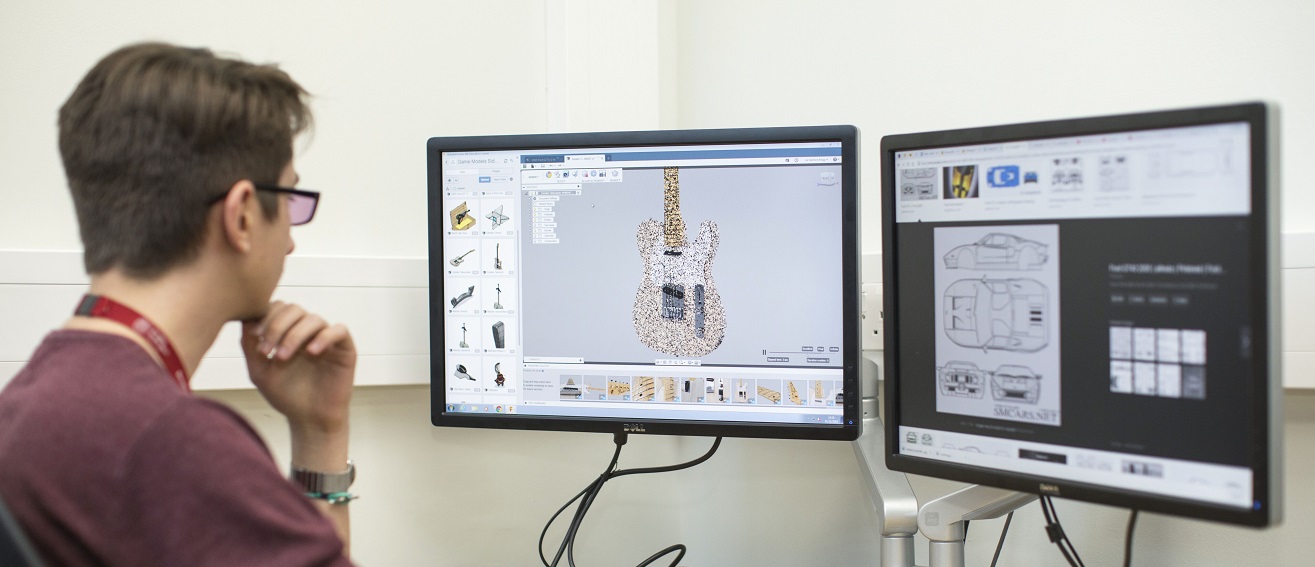Search our site...
Search module
Overview
Do you have a creative mind to make available to science? Can't wait to provide the industry with some new mind-blowing product nobody had seen coming? Then this course is the right place for you to develop your passion and skills.
Why Product Design and Development Engineering at LSBU?
- star
- Reputation The School of Engineering has run both Design and Mechanical Engineering degrees for over fifty years, so we have built up a vast range of alumni and contacts in industry
- cogs
- Workshops Our prototyping workshops range from soft-modelling & woodwork to metalwork & 3D printing. Our engineering laboratories include strength of materials, fluid dynamics, engine dynamometer
- award
- Competition Winning students/alumni In recent years students have been placed in the following competitions Design Innovation in Polymers, StarPack
- map-marker
- Location Southwark SE1
- trophy
- Accreditation iED in due course
- clock
- Duration Four years, part-time academic study plus up to one year for End Point Assessment
Further information
The full apprenticeship standard and assessment plan can be found on the Institute for Apprenticeships.
| ModePart-time | Duration4 years | Start dateSeptember | Application code5759 | Application method Direct to LSBU |
Location
London South Bank University student union is located at 103 Borough Rd, London SE1 0AA.
If you are visiting our Southwark Campus, you may wish to use our downloadable campus map (PNG File 466 KB). For information on accessibility, see our DisabledGo access guides. See our location page for more details.
Entry Level Requirements
Candidates will be employed by a company operating in relevant fields of engineering or technology or design and be nominated by that company to undertake a PDDE Apprenticeship.
Candidates must have the following entry requirements:
- 5 GCSEs A-C (including Maths and English) or equivalent (reformed GCSEs grade 4 or above).
PLUS
- A Level BBB (must include Maths), or;
- BTEC National Diploma DDM or;
- Access to HE qualifications with 24 Distinctions and 21 Merits (must include a minimum of 3 Merits in Design Technology, Maths and Physics) or;
- Entry level 3 qualifications worth 122 UCAS points (must include Maths or Physics)
Candidates are normally interviewed by LSBU before being offered a place and are asked to bring along evidence of their design thinking, this can take the form of a selection of imagery (portfolio) that showcases these skills. There is no such thing as a ‘standard’ portfolio. In short, we would like to see exciting example sheets of design or other creative work, which collectively illustrate a breadth of skills. This might include (in no particular order):
- Problem-solving
- 2D sketch work
- Creative thinking (mind maps, spider diagrams)
- Colour treatments
- Photography
- 3D collages
- 3D sculpture
- 2D and 3D prototyping/model making
- CAD or other digital work
- Presentation drawings/boards
Accredited Prior Experiential Learning (APEL)
APEL may be considered in determining the entry requirements for candidates with relevant academic qualifications and/or work experience but cannot replace the requirement for formal qualifications in Mathematics.
Direct Entry
Applicants may be considered for advanced entry. Applicants will be interviewed and will be required to have formal prior qualifications to demonstrate preparedness for direct entry.
Choose your country
Select country here:
Missing English and Maths qualifications?
If you do not have the required English and Maths qualifications needed to satisfy the entry requirements for this programme, we have courses available at our partner College that you can take to upskill in these areas. Find out more at South Bank College.
Funding
The cost of the apprenticeship is paid fully by the employer (sometimes part funded by the government) through apprenticeship levy. The apprenticeship levy is a pot of money some companies pay into, which all businesses have access to spend on the training costs of apprenticeships. Companies fall into two categories: levy-payers (who pay into the pot) and non-levy payers (who do not). You can find out more in our Levy and Funding section, specifically for employers
The apprentice does not contribute toward the cost of study.
Bands
Apprenticeship standards are all assigned a funding band by the Government – these funding bands are the maximum amount the Government will fund via the levy towards a given apprenticeship standard. There are currently 30 funding bands ranging from £1,000 to £27,000.
Incentives
Employers with less than 50 staff sending an apprentice aged 16-18 will have 100% of the training costs paid by the government. All employers who employ an apprentice aged 16-18 on the first day of teaching will receive a £1,000 incentive from the government. You can find out more in our Levy and Funding section, specifically for employers.
Cost
You can find out the funding band for an Apprenticeship Standard on the Government website. To find out how much we are charging, please get in touch with us at apprenticeships@lsbu.ac.uk
Field trips
Some modules include field with and site visits, which may be residential or outside the United Kingdom, ranging from three to five days. These are organised by the Division and students are required to contribute towards the cost. If there are any field trips or any course visits as part of your course, we will let you know in good time.
Home
| Mode Part-time | Duration 4 years | Start date September | Application code 5759 | Application method Direct to LSBU |
An Apprenticeship Standard is comprised of a programme of study, an End Point Assessment and on-the-job learning. This means that in addition to meeting academic requirements, you’ll need to be employed in a role related to your apprenticeship. The process of applying depends on whether you have an employer to sponsor (and support) you.
If you are employed and your employer has confirmed they will support your apprenticeship:
You are welcome to submit an application via our application system. You’ll need to provide details of your employment/employer as part of the application. You’ll also need to ensure you and your employer meet the requirements – find out who can be an apprentice to see if you meet the entry requirements and employer commitments to find out more about your employer’s role.
If you are not employed:
- You will need to find a job role related to the apprenticeship you wish to apply for, with an employer who is happy to support you. If you would like to find an employer to support your apprenticeship with LSBU, you can search which employers are currently advertising Apprenticeships via the National Apprenticeship Service website searching for ‘London South Bank University’ as keywords.
- If there are no search results, this means there are currently no vacancies. We update our vacancies regularly, so please do check back regularly.
- Many employers advertise their apprenticeship vacancies on their websites or via other portals. You could search for ‘find an apprenticeship’ online.
- When you’re ready to apply, see the government's advice on how to write a winning apprenticeship application and make your application.
Further information for apprentices
If you’re a prospective apprentice, you can find out more about who can be an apprentice on our student pages.
Further information for employers
If you’re an employer, you can find information about the employer commitments and further related information on the related pages for business.
See our admissions policy 1.0 MB and complaints policy 516.0 KB.
Prepare to start
There are steps the apprentices, the employer and the University need to complete before you start your course. Take a look at the steps to be completed in the Enrolment section. Employers may also like to look at our steps to offering an apprenticeship.
The modules that you will undertake will help to build your core skills and experience: the production of design drawings, digital design skills in CAD and graphics, technical engineering analysis, presentation and communication skills and the production of working prototypes. Throughout your course you will be given a platform to build your network through live briefs, industry career talks and your final year degree show.
Level 4
- Design Methods - 40 credits
The module is an introductory experience for apprentices and covers the majority of practical work to be undertaken at first year level – design methods, process and projects. Using design projects as a vehicle, students will cover design methodology, physical prototyping, workshop skills, and an introduction to materials and manufacturing technology. Assessment: 100% coursework - CAD 1 - 20 credits
The module provides an introduction to the principles and use of Computer Aided Design techniques and software for Product and Engineering design. It includes a grounding in Engineering Drawing techniques and conventions Assessment: 100% coursework - Introduction to Mechanical and Electrical Engineering - 20 credits
Good designers are often good engineers, and vice versa. This module gives you the foundational principles of mechanical engineering – how things move, how they interact, and how they break – and of electrical engineering – how we power our designs, how we control them, and how we observe them. The module combines taught content with practical engineering design, in which students build a functioning engineered system to perform a given task. Assessment: 100% coursework - Mathematics - 20 credits
PDDE apprentices have to be good mathematicians - highly numerate, confident in scientific analysis, and able to make leaps of logic. Maths is developed through experience and practice, and so this module is designed to reinforce familiar mathematical concepts and to introduce new ones. The maths you learn here then feeds directly into other modules. Assessment: 100% exam - Visual Communications - 20 credits
As a designer you need to communicate your ideas to other people and to develop your design concepts and ideas in two dimensions. This module includes free hand drawing and sketching, technical drawing, graphic communication, and digital visual tools. You will learn to draw (and to use drawing as a design thinking and problem solving tool) and how to present your work in a clear and professional way. Assessment: 100% coursework
Level 5
- Designs Contexts and Communications - 20 credits
The module will enhance fundamental employability skills for a graduate in the contemporary design industry. It builds on the concepts that were introduced in level 4 modules, with a view to creation of a professional portfolio to support their End Point Assessment (EPA). Assessment: 100% coursework. - Solid Mechanics and FEA - 20 credits
This module will provide new concepts in the deformation of materials under different loading conditions and extend the application of fundamental principles of solid mechanics to more advanced systems, building on knowledge gained through Introduction to Mechanical and Electronic Engineering (at Level 4). The module will provide basic concepts and the principles of the finite element analysis (FEA) techniques and the application of FEA in structural and stress analysis Assessment method: 70% exam, 30% coursework - Machine Drives and Mechatronics - 20 credits
This module provides an introduction to the inter-disciplinary field of mechatronics. It is traced from its origins through the integration of fine mechanical engineering with electronics and computer control, to modern day products and processes. Particular attention is paid to sensors and actuators, and microcontrollers. Students will learn through laboratory experiments about the hardware components and subsystems used in the mechanical and mechatronics control in real engineering applications. Assessment: 70% exam, 30% Coursework - CAD 2 - 20 credits
This module will develop the apprentice’s understanding and skills with regard to the use of computing tools in engineering design; extending their ability to appropriately select and then apply established design theory alongside product development and prototyping techniques to effect comprehensive solutions to a wide range of open-ended engineering problems. Assessment: 100% coursework - Design and Manufacture Project - 20 credits
The module will allow students to couple their ‘design thinking’ techniques and methods with engineering analysis and practical skills through application in the design development and production of a working prototype of a product. It provides an opportunity to showcase your engineering design skills at the highest level yet in preparation for seeking an industrial placement. Assessment: 100% coursework - Design Thinking and Applications - 20 credits
The module will build on the experience in the Design Methods and other first year modules and aims to develop design thinking methodology and product development practice for the final year projects. The module will allow students to experience a thorough range of design process cycles and develop various resolution prototypes in relation to the weighting of the assignments. You will need to reflect on the increasing diversity in product, service, interaction design and “design thinking” as a component of business development. Assessment: 100% coursework
Level 6
- Research Methods for Design Projects - 20 credits
In this module students identify a suitable subject for the Engineering Product Design Project; you then develop a project brief and work plan, which are presented visually and verbally in addition to their preliminary contextual research and justification for the proposed project. Students also develop brand identity for the Design Degree Show, which may be pitched to experts and/or design professionals. Assessment: 100% coursework - Portfolio Engineering Projects - 20 credits
This module will develop apprentices’ professional skills and portfolio in preparation for a career as a Design Engineer. Apprentices will apply knowledge and understanding of a range of Engineering Design principles and techniques to analyse and solve design problems, exploring design alternatives and understanding the implications of trade-offs in the design process. They will learn how to prototype and implement their proposed solutions using appropriate digital manufacturing technologies. In addition to this there will be significant content relating to management of the design process, presentation of ideas, and working in teams. Assessment: 100% coursework - Innovation and Enterprise - 20 credits
This module forms part of the common Engineering curriculum for the University. It is intended to be practical, with apprentices developing ideas of their own in such a way that they become real business propositions. Apprentices will practice ways of finding and testing ideas and then developing them, and will construct business strategies, risk assessments and scenario tests, so that they can demonstrate the commercial viability of their ideas. The module also covers aspects of intellectual property. Assessment: 100% coursework - Engineering Product Design Project - 60 credits
The Engineering Design Project requires apprentices to develop an engineered solution from concept through to artefact based on a given topic (identified via Research Methods for Design Projects). The artefact may be physical and/or digital. The project deliverables include a detailed record of the design development process, a fully-developed artefact, and an analytical report that demonstrates the application of technical engineering expertise to the proposed solution. The project provides an opportunity to explore a chosen specialist field in order to develop expertise and demonstrate depth of understanding. In order to execute their individual projects apprentices will draw on selected tools and resources learned in previous modules and produce a coherent and professional methodology for the intended solution. Assessment: 100% coursework
Careers
Employability Service
By completing the apprenticeship route, you’ll have the advantage of having real-world work experience, working in a role related to your area of study. This will give you a competitive edge among other graduates when you complete your apprenticeship standard.
During your studies – and for two years after you graduate – you’ll have access to our Employability Service, who can help you develop your skills through the Careers Gym workshops and presentations. Our JobShop advisers support students and graduates with finding the right job for them.
We are University of the Year for Graduate Employment - The Times and Sunday Times Good University Guide 2018.
All the way through the course, employability skills are promoted – with guest speakers from industry, business insights, graduate start-up and entrepreneur schemes. Jobs directly related to an apprenticeship degree in Product Design & Development Engineering include:
- CAD Engineer
- Production Engineer
- Product Designer
- Mechanical Design Engineer
- Manufacturing Engineer
- New Product Developer
- Product Engineer
- Prototyping Engineer
- Human Factors Engineer
Benefits of the apprenticeship standard route
By studying the apprenticeship route, you gain real world work experience combined with a better understanding and analysis of your daily tasks, building skills and contacts. You will build the intellectual capacity required to think critically, and the practical skills to develop and communicate design ideas through processes of thinking, making, giving you the edge on graduation.
Continuing your studies
When you graduate from this course, you will be able to apply for further study at postgraduate level, and the academic strength of this course means that you can also consider entering the field of academic research.
The Division of Mechanical Engineering and Design has active links with the following organisations:
- The Institution of Engineering Designers
- SharkNinja
- Brompton
- Oxford Products
- The Marketing Store
- Airlander
Teaching and Assessment
Apprenticeship structure
The course will be a mixture of lectures, tutorials and practical based exercises and will be assessed by a wide variety of methods including, design project portfolios, presentations and examinations.
All students are allocated a personal tutor who they will normally meet with once per semester. As an apprentice they will also be allocated a Skills Assessor who will be ensuring that regular progress reviews take place and that they are on track for completion of the apprenticeship.
Duration
4 years academic programme plus up to 1 year preparation for EPA
Delivery
Day release
Assessment
96% coursework assessed
End point assessment
Degree apprenticeship assessed by EAL
People profiles
Register your interest
Apprentice Guide
Download our guideContact information
Course Enquiries - UK
Tel: 0207 815 7500




